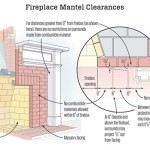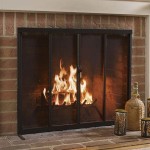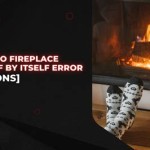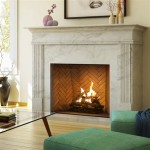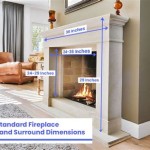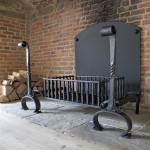In The Wall Fireplaces: A Comprehensive Guide to Gas Options
In-wall fireplaces, particularly those utilizing gas as a fuel source, represent a significant design element and heating solution for modern homes. These fireplaces are characterized by their integration directly into the wall structure, offering a streamlined and space-saving alternative to traditional freestanding fireplaces. This article provides a detailed examination of in-wall gas fireplaces, exploring their features, benefits, installation requirements, and various considerations relevant to their selection and operation.
The popularity of in-wall gas fireplaces stems from a combination of aesthetic appeal and functional advantages. Their flush-mounted design allows for seamless integration into a room's decor, creating a clean and contemporary look. Unlike wood-burning fireplaces, gas fireplaces offer ease of use, requiring no manual loading of fuel. A simple switch or remote control activates the flame, providing instant heat and ambiance. Furthermore, gas fireplaces offer greater control over heat output, allowing users to adjust the flame intensity to suit their comfort levels. This combination of convenience, aesthetic versatility, and efficient heating makes in-wall gas fireplaces a popular choice for homeowners seeking to enhance their living spaces.
Aesthetic and Design Considerations
The visual impact of an in-wall gas fireplace is a primary consideration for many homeowners. These fireplaces are available in a wide range of styles, sizes, and finishes, allowing for customization to complement various architectural designs. From sleek, minimalist models to more traditional designs featuring decorative surrounds, the options are extensive.
The design of the firebox itself also contributes to the overall aesthetic. Options include traditional log sets, which mimic the appearance of a wood-burning fire, as well as contemporary glass or stone media, creating a more modern and sophisticated look. The choice of media significantly impacts the perceived style of the fireplace. For instance, a log set and a brick-patterned firebox interior can evoke a rustic, traditional feel, while a glass media bed and a stainless-steel surround project a more modern aesthetic.
Framing materials surrounding the fireplace also play a crucial role in its overall design. Options include wood, stone, tile, or metal, each offering a distinct visual character. The framing material should complement the surrounding wall and the room's overall decor, creating a cohesive and visually appealing focal point. Considerations should be given to the size and scale of the framing, ensuring that it is proportionate to the fireplace and the room.
Furthermore, the location of the fireplace within the wall significantly influences its visual impact. Centering the fireplace on a wall creates a sense of balance and symmetry, while offsetting it can provide a more dynamic and modern feel. The height of the fireplace should also be carefully considered, taking into account the viewing angle from seating areas and the overall proportions of the room.
Installation and Venting Requirements
Proper installation is paramount for the safe and efficient operation of an in-wall gas fireplace. Installation should always be performed by a qualified and licensed professional, adhering to local building codes and manufacturer's instructions. Incorrect installation can lead to gas leaks, carbon monoxide poisoning, or fire hazards.
A critical aspect of installation is the venting system. Gas fireplaces require a method for expelling combustion byproducts, such as carbon dioxide and water vapor, to the outside. There are two primary types of venting systems used for gas fireplaces: direct vent and vent-free.
Direct vent fireplaces draw combustion air from outside and exhaust combustion products directly outside through a sealed system. This type of venting is considered the safest and most efficient option, as it prevents combustion byproducts from entering the living space. Direct vent systems typically use a coaxial vent pipe, with one pipe drawing in fresh air and the other expelling exhaust gases. The vent pipe can be routed horizontally through an exterior wall or vertically through the roof.
Vent-free fireplaces, also known as ventless fireplaces, do not require an external venting system. They burn gas very efficiently, producing minimal combustion byproducts. However, vent-free fireplaces are not permitted in all jurisdictions due to concerns about indoor air quality. They are generally equipped with oxygen depletion sensors (ODS) that shut off the gas supply if the oxygen level in the room drops to an unsafe level. Even with these safety features, vent-free fireplaces require careful monitoring and may not be suitable for individuals with respiratory problems.
Gas line installation is another critical aspect of the installation process. A qualified gas fitter must connect the fireplace to the gas supply, ensuring that all connections are tight and leak-free. The gas line must be properly sized to provide adequate gas flow to the fireplace. A shut-off valve should be installed near the fireplace for emergency situations.
Electrical connections are also required for many gas fireplaces, powering features such as the ignition system, remote control, and blower fan. A dedicated electrical circuit should be used to prevent overloading. As with gas line installation, all electrical work should be performed by a qualified electrician.
Efficiency, Safety, and Operational Considerations
The efficiency of an in-wall gas fireplace is measured by its AFUE (Annual Fuel Utilization Efficiency) rating. The AFUE rating indicates the percentage of fuel that is converted into usable heat. A higher AFUE rating indicates a more efficient fireplace. Direct vent fireplaces generally have higher AFUE ratings than vent-free fireplaces.
Safety is a paramount concern when operating a gas fireplace. Regular maintenance is essential to ensure safe and efficient operation. This includes inspecting the venting system for blockages, cleaning the burner assembly, and checking for gas leaks. Carbon monoxide detectors should be installed in the vicinity of the fireplace to alert occupants to the presence of this odorless and deadly gas.
The operation of a gas fireplace is relatively straightforward. Most models are equipped with a simple on/off switch or remote control. Some models offer adjustable flame height and blower fan speed, allowing users to customize the heat output and airflow. It is important to follow the manufacturer's instructions for operating the fireplace safely and efficiently.
Consideration should be given to the heat output of the fireplace, measured in BTUs (British Thermal Units). The appropriate BTU rating depends on the size of the room and the desired level of heating. A larger room requires a fireplace with a higher BTU rating. It is important to avoid oversizing the fireplace, as this can lead to excessive heat and discomfort.
The cost of operating a gas fireplace depends on several factors, including the price of natural gas or propane, the efficiency of the fireplace, and the frequency of use. Gas fireplaces are generally more cost-effective to operate than electric fireplaces, but less cost-effective than wood-burning fireplaces (considering only fuel costs and neglecting the labor and mess associated with wood). Regular maintenance can help to optimize efficiency and reduce operating costs.
In conclusion, in-wall gas fireplaces offer a combination of aesthetic appeal, convenience, and efficient heating, making them a popular choice for modern homes. Careful consideration should be given to design, installation, safety, and operational factors to ensure a satisfying and secure experience. Selecting the appropriate model, ensuring professional installation, and performing regular maintenance are crucial steps in maximizing the benefits of an in-wall gas fireplace.

Napoleon Gas Direct Vent Wall Mount Fireplace Whd31 Fireplaces Hvacdirect Com

Gas Fireplaces Fireplace Xtrordinair Made In America

7 Fireplace Surround Ideas That Will Ignite The Room

Fire Ribbon Direct Vent Slim Gas Fireplace Spark Modern Fires

Hole In The Wall Installation Guide Direct Fireplaces

Fire Ribbon Direct Vent Slim Gas Fireplace Spark Modern Fires

How To For A Gas Fireplace Fireplaces Direct Learning Center
Custom Luxury Gas Fireplace Designs Stellar

Gazco Studio Edge Hole In Wall Gas Fire York Fireplaces Fires

Vent Free Archives SÓlas Contemporary Fireplaces

